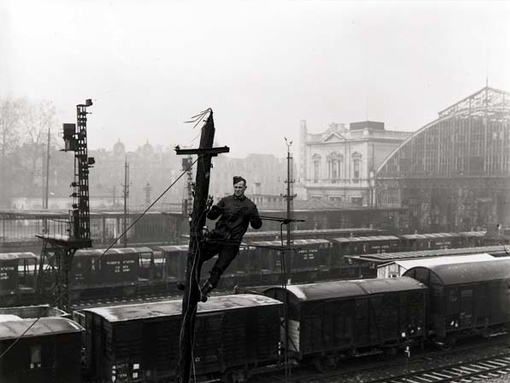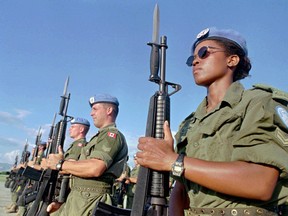You’re very French, you’re riding a first-class carriage with a third-class ticket - Sez the French Ambassador
I have a new hero....
Peut-etre?
Naval (Sic)-gazing Canada has neglected its military, new French ambassador says
The problem, in part, is that Canada has grown too reliant on the U.S. and its massive defence machine, the most costly in the world, Michel Miraillet said
Author of the article:
Tom Blackwell
Publishing date:
Oct 14, 2022 • 38 minutes ago • 4 minute read •
16 Comments
Canadian peacekeepers in Haiti in 1997. "In military terms, this country is less present than it was 10 or 15 years ago," France's ambassador said of Canada. PHOTO BY DANIEL MOREL/AP, FILE
Caught up in naval (sic)-gazing and living under the protective shield of the United States, Canada has allowed its military presence worldwide to wither over the last decade or so, France’s new ambassador to Ottawa suggested Friday.
In blunt comments that he said reflected his own personal opinions, Michel Miraillet argued Canada needs to boost its defence capabilities as threats increase from the likes of China, Russia and North Korea.
The problem, in part, is that Canada has grown too reliant on the U.S. and its massive defence machine, the most costly in the world, he said.
“It’s always difficult for a country that by its nature is highly protected, with a big guy below who is a big pain in the neck but at the end of the day, well, it works,” said Miraillet. “You’re very French, you’re riding a first-class carriage with a third-class ticket…. If you want to remain in the first-class seat, you need to train and expand and to go somewhere.”
“This country in some ways may be too comfortable, too comfortable.”
The ambassador’s remarks were by no means the first time someone from outside this country has criticized Ottawa’s recent defence spending record. U.S. presidents have long urged Canada and other lagging members of NATO to meet the alliance’s recommended goal of allocating two per cent of GDP to the military.
But it’s unusual to hear a similar complaint from another of Canada’s allies, albeit one whose arms industry might profit from increased equipment buying from Ottawa.
RECOMMENDED FROM EDITORIAL

Canada slips further away from NATO's 2% defence spending benchmark

U.S. Ambassador says Canada didn't live up to its own hype on defence spending
According to NATO figures, France is 11th among the group’s 29 nations, spending just under the two-per-cent target — 1.90 per cent of GDP. Canada is 24th, budgeting just 1.27 per cent of gross domestic product for defence.
Miraillet, a former director general for global affairs, acknowledged Canada’s recent contributions to international defence, including its involvement in Afghanistan, soldiers sent to Baltic countries and training of Ukrainian troops.
He also said that this country has a “fantastic” reputation in France as a sympathetic nation with similar values.
But the ambassador said he recalls a day when, for instance, Canada was a major contributor to United Nations peacekeeping, a contrast to today’s situation.
After reaching a high point in 1993, when over 3,300 Canadians were deployed on peacekeeping missions, the number dwindled to just 54 this year, figures compiled by Royal Military College Prof. Walter Dorn indicate.
“At the end of the day, I have the feeling that in military terms, this country is less present than it was 10 or 15 years ago,” said Miraillet. “Canada was far more present in the past in Africa than it is now…. There is a need to have more Canada on the ground, not only in Africa but also in Asia.”
He suggested as well that threats in this country’s backyard are growing, with China sending icebreakers into the Arctic, possibly heralding the arrival of Peoples Liberation Army submarines. Meanwhile, Russia has deployed more attack submarines than ever, said the ambassador.
You’re very French, you’re riding a first-class carriage with a third-class ticket
But he said Canada has a “huge problem” with its own submarine fleet, calling them “very old” ships. In fact, the second-hand vessels bought from the U.K. have been plagued with mechanical problems, triggering high-cost repairs. Miraillet also called into question the North American Aerospace Defense Command (NORAD), the joint U.S.-Canada continental defence program.
“You are now confronted with a situation where NORAD looks like an old Volvo 240. I mean it’s strong, but you have to beef it up.”
Instead of looking beyond its borders at security threats and humanitarian needs worldwide, Canada seems consumed by internal political discussions, especially over “gender” issues, said Miraillet.
“Now I have this sentiment — this is very personal — but the country is really belly-button focused, more than ever.”
His remarks — delivered with self-deprecating humour — may not have been completely altruistic. France has a major arms industry and recently was stung by Australia’s decision to scrap a deal to buy 12 French-made diesel-electric submarines. They are to be replaced by eight nuclear subs it will buy from the U.S. instead. The Royal Canadian Navy has said it is looking at purchasing a new submarine fleet.
The ambassador cited an incident in the early 90s when the Canadian navy approached France about buying attack submarines from it, only for the U.S. to scuttle the discussions. But he suggested Canada needs a bigger military to respond to international security risks, regardless of where it buys its equipment.
“I’m not telling you that you need to buy French frigates — though that would be a sign of good taste,” he said with a smile. “But on the other hand, what I want to see is just to have enough capacities to be ready … just for deterrence.”






